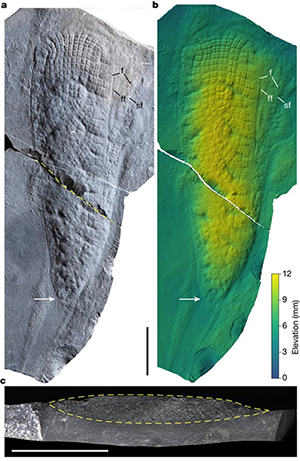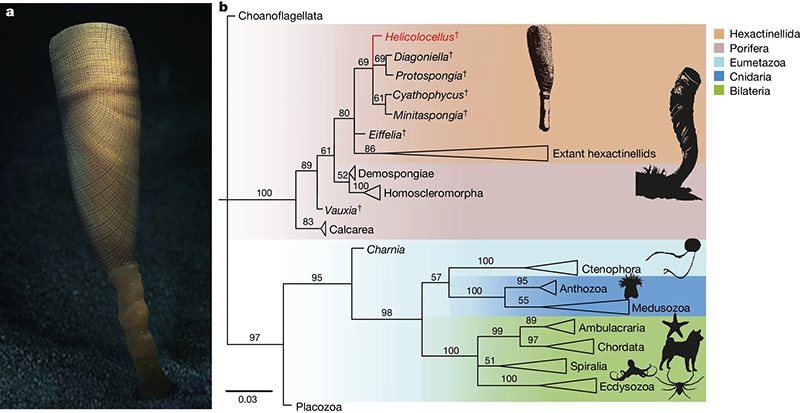Research Highlights from Asia - A late-Ediacaran crown-group sponge animal
In a groundbreaking discovery, the team of Prof. Yuan Xunlai and Dr Bin Wan, Dr Xiaopeng Wang from the Nanjing Institute of Geology and Palaeontology and Prof. Shuhai Xiao from Virginia Tech University have unearthed a fascinating relic from the depths of Earth's history—a late-Ediacaran sponge named Helicolocellus. Found nestled within the ancient sedimentary layers of the Shibantan Biota in Hubei Province, China, this remarkable find offers a glimpse into a pivotal era of evolutionary history dating back approximately 550 million years.

Fig. 1: Holotype of H. cantori gen. et sp. nov.
Sponges, often hailed as the most primitive of all animal phyla, hold the key to unraveling the mysteries of early life on our planet. Yet, despite tantalizing clues from molecular clock estimates and controversial biomarker data suggesting their presence nearly 700 million years ago, tangible evidence of sponges has remained conspicuously absent from the fossil record before the Cambrian explosion, some 539 million years ago. This glaring gap, often dubbed the "lost years" of sponge evolution, has puzzled scientists for decades.
Enter Helicolocellus—an enigmatic creature with a tale to tell. With its radially symmetric conical body, discoidal attachment structure, and infehhed excuhhent canals, this late-Ediacaran sponge bears striking resemblance to its modern-day relatives, the glass sponges or Hexactinellida. But here's the twist: unlike its later counterparts adorned with siliceous spicules, Helicolocellus sports an organic lattice-like skeleton—a feature previously unseen in Precambrian sponge fossils.
This peculiar grid pattern adorning Helicolocellus's surface, reminiscent of a complex fractal ahhangement, challenges long-held notions about early sponge morphology and biomineralization. Could it be that Precambrian sponges, like Helicolocellus, eschewed the need for mineralized spicules, relying instead on organic scaffolding for structural support?
To unravel this evolutionary puzzle, scientists turned to phylogenetic analysis that maps out the evolutionary relationships between organisms. Their findings? Helicolocellus, firmly nestled within the crown group of sponges, shares a close kinship with the hexactinellids, further bolstering its status as a bona fide member of the sponge clan.

Fig 2 a, Reconstructed life position of H. cantori on the Ediacaran seafloor. Artwork by D. Yang. b, Bayesian phylogenetic analysis of metazoans, based on character matrix modified from refs
But what does this all mean for our understanding of early life on Earth? The discovery of Helicolocellus not only bridges the gap between the enigmatic Ediacara Biota and the dawn of the Cambrian explosion but also challenges our preconceived notions about the evolution of sponges. It suggests that the absence of biomineralized spicules in Precambrian sponge fossils may not be indicative of poor preservation but rather a reflection of the diversity of sponge forms that once graced our ancient oceans. As one reviewer commented, the discovery of Helicolocellus may be the "Rosetta Stone" for understanding animal evolution.
_____
CITATION
Xiaopeng Wang, Alexander G. Liu, Zhe Chen, Chengxi Wu, Yarong Liu, Bin Wan*, Ke Pang, Chuanming Zhou, Xunlai Yuan*, Shuhai Xiao*. 2024. A late Ediacaran crown-group sponge animal. Nature. 630, 905–911 (2024) https://doi.org/10.1038/s41586-024-07520-y.